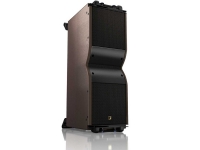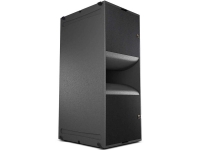ABOUT THE PRODUCT
ABOUT THE MANUFACTURER
GLOSSARY
UPJunior : Ultra Compact VariO Loudspeaker
Meyer Sound’s UPJunior ultracompact VariO loudspeaker brings the sonic signature, flexible rigging, and extraordinary power‑to‑size ratio of the award-winning UPJ-1P to an even more compact package suitable for a broad range of applications. The UPJunior combines the advantages of self-powered systems with the placement and arraying flexibility afforded by an 80° x 50° VariO rotatable horn and QuickFly rigging. Though remarkably compact and lightweight, the UPJunior delivers a linear peak SPL of 123.5 dB with 18.5 dB crest factor, making it suitable for use as either a single, primary loudspeaker or within multi-cabinet horizontal and vertical arrays. Applications include audio-visual presentations, small- to medium-sized sound reinforcement systems, fill, delay, effects, and under-balcony coverage, as well as distributed systems. Meyer Sound designed the UPJunior for flexibility. Whether oriented vertically or horizontally, its easily rotatable VariO horn facilitates the optimum horizontal and vertical coverage in any situation. As a self-powered loudspeaker, the UPJunior incorporates a two‑channel, class AB/bridged power amplifier and sophisticated control circuitry housed within the cabinet, dramatically simplifying setup and installation. The UPJunior’s on-board amplifier delivers 580 W of total burst power. The optional RMS remote monitoring system provides comprehensive monitoring of loudspeaker parameters from a Mac or Windows-based computer running Compass control software. The UPJunior’s low-mid frequency section employs an 8-inch neodymium magnet cone driver, while the high-frequency section utilizes a 2-inch diaphragm compression driver. Meyer Sound designed and manufactures both drivers in its Berkeley, California factory. The UPJunior is extraordinarily versatile: mounted, flown, and arrayed, use it as either a main loudspeaker or fill loudspeaker, or even as a stage monitor. The UPJunior’s cabinet includes end plates made of heavy-duty, high-strength, corrosion-resistant 6061-T6 aluminum, complete with threaded M8 attachment points for basic eyebolt rigging or third-party pole assemblies. QuickFly rigging options including the MAAM‑UPJunior array adapter (also made from 6061-T6 aluminum), the MUB‑UPJunior U-bracket, and the MYA‑UPJunior mounting yoke assembly. Other options include weather protection for fixed applications and custom color finishes for specific cosmetic requirements.Features & Benefits
- Exceptional fidelity and extended high frequency enhance performance
- Compact package delivers outstanding power capability
- Predictable and consistent performance ensure system design flexibility
- VariO horn enables versatile coverage options, whether orienting loudspeakers horizontally or vertically
- Extraordinarily flat amplitude and phase response provide tonal accuracy and precise imaging
- Constant-Q horn affords uniform response throughout the coverage area
- QuickFly rigging facilitates mounting as a single cabinet or flying within arrays
Applications
- Portable and installed audio-visual systems
- Theatrical sound reinforcement
- Front and under-balcony fill
- Stage monitoring (with optional MAAM‑UPJunior array adapter)
- Conference centers, presentations, ballrooms, and houses of worship
Professional used lighting equipment.| Professional second hand lighting equipment.| Professional pre owned lighting equipment.
Professional used audio equipment.| Professional second hand audio equipment.| Professional pre owned audio equipment.
Second hand audio gear. | Second hand lighting.
Pro audio equipment, second hand amplifiers, DJ, second hand sound systems, second hand Microphones, second hand Media Players.
Outdoor & Indoor LED screens for sale, LED mobile truck.
Light trussing, Gebrauchte Veranstaltungstechnik, used stage equipment Stage & Theatre lighting products.
Used Meyer Sound Laboratories
Meyer Sound Laboratories is an American company based in Berkeley, California that manufactures self-powered loudspeakers, multichannel audio show control systems, electroacoustic architecture, and audio analysis tools for the professional sound reinforcement, fixed installation, and sound recording industries.
The company’s emphasis on research and measurement has resulted in the issuance of dozens of patents, including for the now-standard trapezoidal loudspeaker cabinet shape. Meyer Sound has pioneered other technologies that have become standard in the audio industry, including: processor-controlled loudspeaker systems, self-powered loudspeakers,curvilinear arraying, cardioid subwoofers, and source independent measurement.
Meyer Sound has consistently involved itself with advanced research beyond that connected to immediate product development, sometimes in conjunction with arms of the University of California, Berkeley. Some of this research has resulted in unusual products such as their parabolic sound beam and sound field synthesis loudspeakers. Other projects, such as the spherical loudspeaker research underway by Meyer Sound and CNMAT (Center for New Music and Audio Technologies) at UC Berkeley are still in the stage of pure research.
Professional used lighting equipment.| Professional second hand lighting equipment.| Professional pre owned lighting equipment.
Professional used audio equipment.| Professional second hand audio equipment.| Professional pre owned audio equipment.
Second hand audio gear. | Second hand lighting.
Pro audio equipment, second hand amplifiers, DJ, second hand sound systems, second hand Microphones, second hand Media Players.
Outdoor & Indoor LED screens for sale, LED mobile truck.
Light trussing, Gebrauchte Veranstaltungstechnik, used stage equipment Stage & Theatre lighting products.
Octave: The difference between two frequencies where one is twice the other. For example, 200 Hz is an octave higher than 100 Hz. 400 Hz is one octave higher than 200 Hz.
Optical Digital Cable: Fiber optic cable that transfers digital audio signals as light pulses.
Outcue/Outq/Out-Point: These words all refer to the final few seconds of audio signifying the conclusion of the production.
Package: A completed and fully edited audio piece.
Passive: Not active. A passive crossover uses no external power and results in insertion loss. A passive speaker is one without internal amplification.
Phase: Time relationship between signals it’s all relative.
Power Output: A measure, usually in watts, of how much energy is modulated by a component.
Preamplifier: A control and switching component that may include equalization functions. The preamp comes in the signal chain before the amplifiers.
Pre Outs: Connectors that provide a line-level output of the internal preamp or surround processor.
Pre Outs/Main Ins: Connectors on a receiver that provide an interruptible signal loop between the output of the internal preamp or surround processor portion of the receiver and the input of the amplifier portion of the receiver.
Pre/Pro: A combination preamp and surround processor.
Processors: Anything that processes an incoming signal in some way. Surround processors, for example, can decode a Dolby Digital signal to send to an amp so you can hear it.
Pulse Code Modulation: (PCM) a way to convert sound or analog information to binary information (0s and 1s) by taking samples of the sound and record the resulting number as binary information. Used on all CDs, DVD-Audio, and just about every other digital audio format. It can sometimes be found on DVD-Video.
Q-and-A: Question and answer session.
Receiver: Any component that receives, or tunes, broadcast signals, be it NTSC, HDTV, DBS, or AM/FM radio. Typically refers to the single component that includes a preamp, surround processor, multichannel amplifier, and AM/FM tuner.
Reverberation: The reflections of sound within a closed space.
RF: Radio Frequency. Television signals are modulated onto RF signals and are then demodulated by your television’s tuner. VCRs and DBS receivers often include channel 3 or 4 modulators, allowing the output signal to be tuned by the television on those channels. Also, laser discs used an RF signal for modulating Dolby Digital 5.1 soundtracks on some movies. This requires an RF demodulator (usually referred to as an AC3-RF demodulator) before or in the surround processor to decode the signal.
RMS: Root Mean Square or the square root of the arithmetic mean (average) of the square’s set of values. A reasonably accurate method of describing an amplifier`s power output.
SACD: Super Audio CD. Enhanced audio format with up to six channels of high-resolution audio encoded using DSD. Requires an SACD player. Multichannel also requires a controller with six-channel analog or proprietary digital inputs for full playback.
Sampling Frequency: How often a digital sample is taken of an analog wave. The more samples taken, the more accurate the recording will be. You need to sample at a minimum of twice the highest frequency you want to capture. For example, the 44.1-kilohertz sampling rate of a CD cannot record sounds higher than 22.05 kilohertz.
Scener: A radio report in which the announcer is recorded at the same time and place as the background sound of an event.
Sensitivity: A measurement (in dB) of the sound-pressure level over a specified frequency range created by a speaker driven by 1 watt (2.83V at 8 ohms) of power with a microphone placed 1 meter away.
Signal-to-Noise Ratio: A comparison of the signal level relative to the noise level. Larger numbers are better.
Simultaneous Interpretation: This system allows attendees to hear the meeting in their own language.
Sound Bite: A portion of audio of someone speaking.
Sound field: The total acoustical characteristics of a space, such as ambience number, timing, and relative level of reflections ratio of direct to reflected sound RT-60 time etc.
Soundstage: The area between two speakers that appears to the listener to be occupied by sonic images. Like a real stage, a soundstage should have width, depth, and height.
Speaker: A component that converts electrical energy into acoustical energy.
SPL: Sound-Pressure Level. Measured in dB.
Subwoofer: A speaker designed to reproduce very low bass frequencies, usually those below about 80 Hz.
THX: Certification program for home theater equipment. Uses some proprietary features, but mostly assures a base quality level for a given room size. (See THX select or Ultra.) Is compatible with any and all soundtrack formats. Stands for either Tom Holman’s eXperiment, after the engineer who drafted the original standard, or is named after the company’s founder George Lucas first movie, THX 1138. Nobody agrees on which.
THX select: Certification program for speakers and receivers that assures a base level of quality and performance when played in a room that’s between 2,000 and 3,000 cubic feet.
User-Generated Content (UGC): Text, photos, video or audio supplied by the customers of a company.
Voicer: A radio report without background audio taken from a scene or otherwise.
Wrap: A radio report containing both the reporter and an actuality.
Professional used lighting equipment.| Professional second hand lighting equipment.| Professional pre owned lighting equipment.
Professional used audio equipment.| Professional second hand audio equipment.| Professional pre owned audio equipment.
Second hand audio gear. | Second hand lighting.
Pro audio equipment, second hand amplifiers, DJ, second hand sound systems, second hand Microphones, second hand Media Players.
Outdoor & Indoor LED screens for sale, LED mobile truck.
Light trussing, Gebrauchte Veranstaltungstechnik, used stage equipment Stage & Theatre lighting products.































